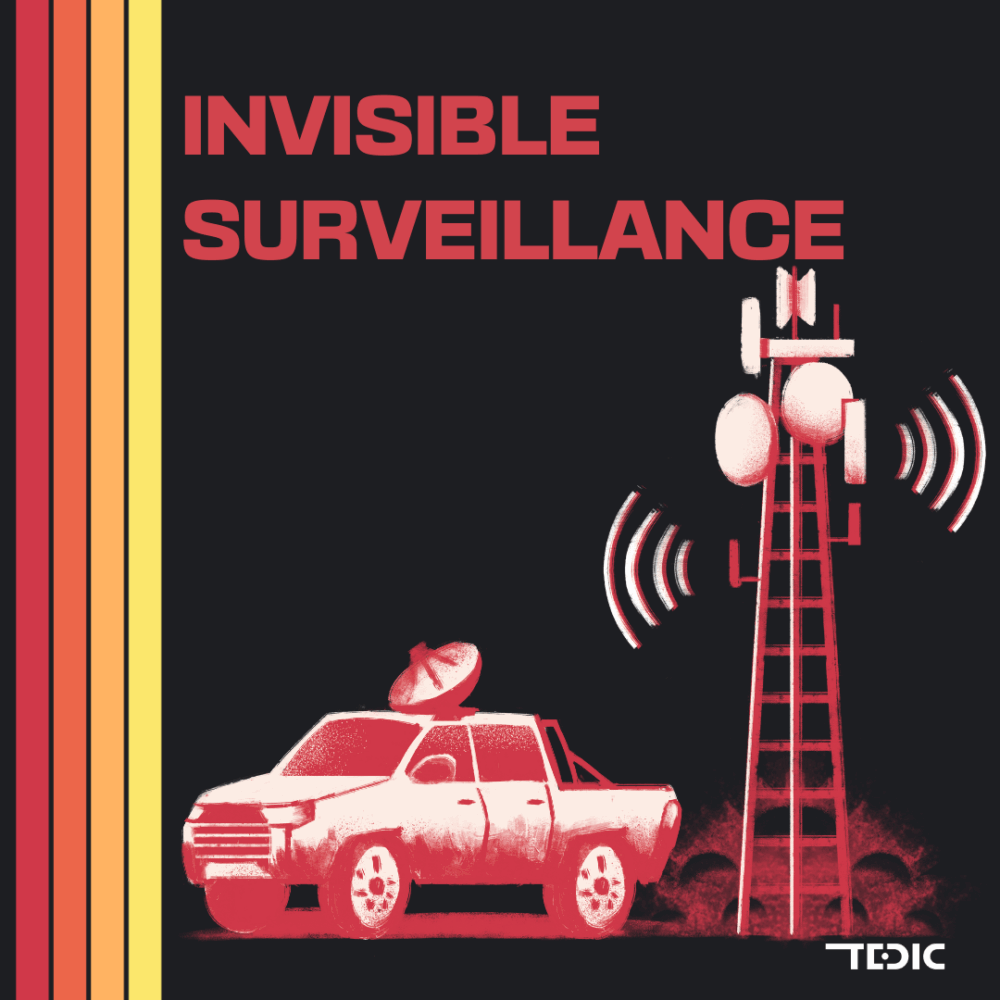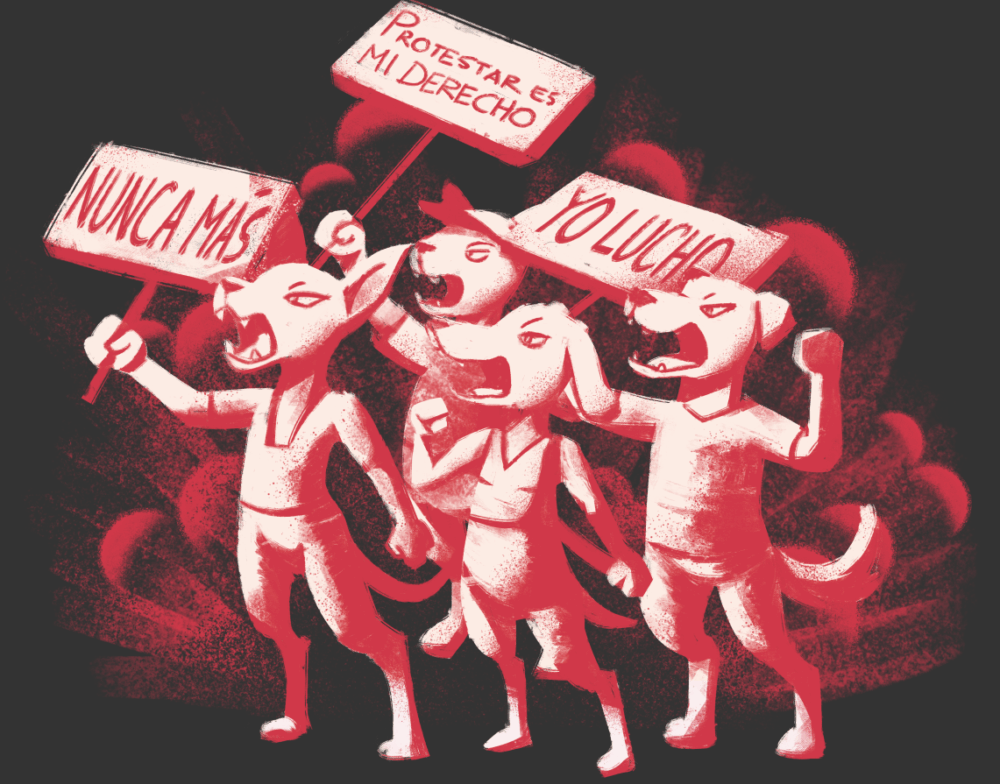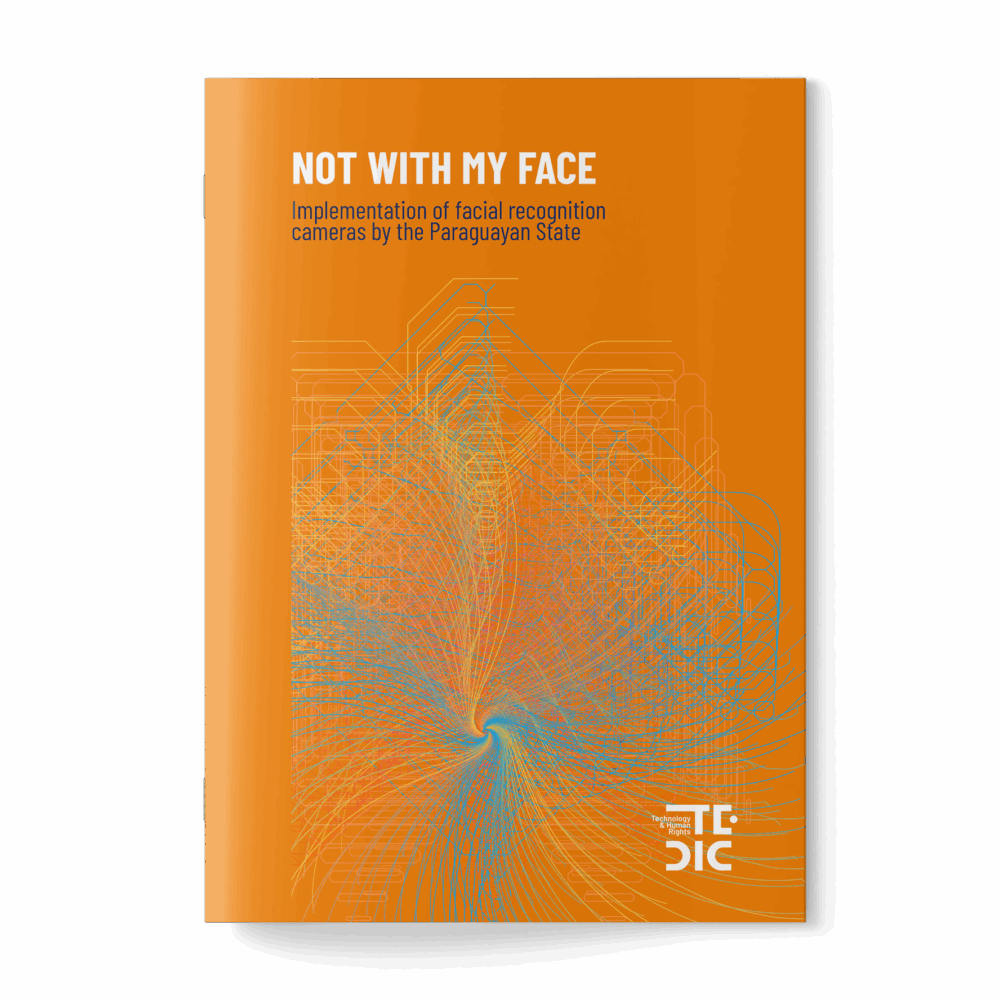
This content was written by Araceli Ramírez
Have you ever wondered if it’s possible to track every phone present at a protest without anyone noticing? The answer is yes — and Paraguay is no exception to this threat. We’re talking about the use of highly intrusive technologies like IMSI catchers — also known as Stingrays or cell-site simulators — surveillance devices that operate in the shadows and, so far, have evaded any kind of regulation or citizen oversight.
What are IMSI catchers and how do they work?
An IMSI catcher is a device that pretends to be a cell tower in order to intercept and collect data from all mobile phones within its range. Its main function is to capture the unique identifiers of devices — such as the IMSI from the SIM card or the IMEI from the phone — without users knowing.

Once connected, the device can:
- Detect the approximate location of any phone.
- Determine which phone number is linked to a SIM.
- Interrupt or block calls and messages.
- In some cases, force the network to downgrade (e.g., from 4G to 2G), making it more vulnerable to the interception of unencrypted communications.
These capabilities turn the IMSI catcher into a tool of mass surveillance, able to gather data from thousands of people without a court order or reasonable suspicion.
The Paraguayan case: Are IMSI catchers being used in our country?
In 2021, TEDIC filed a public information request to find out whether the Paraguayan government had acquired or was using IMSI catchers. The National Police’s response was ambiguous: they stated they “could neither confirm nor deny” their use in Paraguay. This refusal leaves the public in a state of uncertainty and vulnerability.
Through ongoing monitoring of public procurement and import systems, we identified that the Paraguayan state has been acquiring surveillance technologies like these for several years. In particular, we found records of a potential acquisition of interception equipment by the Ministry of the Interior in 2014, during the administration of Horacio Cartes.
Although the purchase of IMSI catchers wasn’t explicitly mentioned, the awarded company in that bid was Septier Communications, an Israeli firm known for manufacturing these devices. This finding heightens concerns about the possible use of mass surveillance tools without public oversight in Paraguay.
Along the same lines, our “Free Protests” guide had already identified other signs of state surveillance in protest contexts, such as:
- Using IMSI catchers to identify everyone present at a protest by collecting unique identifiers from their phones — a practice that, if confirmed, would violate the rights to privacy, freedom of expression, and peaceful assembly.
- A lack of transparency from the Ministry of the Interior and National Police in response to information requests, which further reinforces alerts from national and international human rights organizations.
- Evidence in the public procurement system of surveillance-related purchases, combined with official silence, continues to raise red flags.
- Additionally, Paraguay’s security forces have acquired forensic data extraction tools for mobile devices, such as Cellebrite UFED, which can access private information stored on phones, including conversations in WhatsApp, Telegram, Signal, Facebook, and other apps.
As we write this article, a new procurement notice is active: the Parque Tecnológico de Itaipú (PTI) is seeking to purchase spyware and surveillance software worth 12 million USD. Among the listed solutions is an IMSI catcher system for the Ministry of the Interior, confirming that this technology is not only part of past acquisitions but continues to be a state priority today.
Why does this matter in the context of protests?
Surveillance in protests is not new — but the tools are getting more sophisticated. Today, in addition to physical police presence, invisible technologies are being used that can turn any peaceful protest into a mass data collection operation.
In Paraguay, we’ve documented other forms of protest surveillance, such as:
- Monitoring and data scraping from social media to identify protestors.
- Forensic phone extractions by the Public Prosecutor’s Office.
- Surveillance with facial recognition cameras and drones.
- Using photos and metadata to legally prosecute protestors.
IMSI catchers add a new, hard-to-detect threat to this landscape: they can track people in real time, build profiles, and link them to public events without consent.
What rights are at stake?
The use of mass surveillance technologies like IMSI catchers — especially without regulation, judicial oversight, or public transparency — violates fundamental rights and undermines the very foundations of the rule of law:
- Right to privacy and personal data protection.
- Right to freedom of expression and peaceful assembly.
- Right to the presumption of innocence, since people are treated as suspects just for being present.
But this is about more than just individual rights — it’s about the architecture of democracy itself. Uncontrolled surveillance redefines the role of the state, shifting it from protector of freedoms to discipliner of dissent. A permanent regime of suspicion is created — especially over activists, human rights defenders, journalists, opposition leaders, and mobilized citizens.
As Shoshana Zuboff warns in The Age of Surveillance Capitalism (2019), “privacy is no longer about having secrets — it’s about the right to have a self.” When it comes to state surveillance tools like IMSI catchers, what’s being eroded isn’t just some abstract notion of privacy, but our very ability to be free, active citizens — without fear or invisible constraints.
Moreover, surveillance in protests is not neutral or universal. As Simone Browne points out in Dark Matters: On the Surveillance of Blackness (2015), surveillance technologies reproduce racialized, classist, and colonial logics of control, disproportionately affecting already vulnerable or dissenting groups.
In Paraguay, this likely means increased surveillance of young people, racialized communities, low-income sectors, and TLGBIQ+ populations.
From a technopolitical perspective, it’s key to recognize that these technologies don’t just collect data — they produce social order: they seek to discourage political participation, instill fear, and limit dissent. The effect is not only technical, but symbolic and cultural: the fear of being watched becomes a mechanism of self-censorship and demobilization.
Allowing these tools to operate secretly and without citizen control is to renounce our sovereignty as a democratic society. There can be no talk of a free society if we cannot protest without being watched.
What can you do? How can you protect yourself?
At TEDIC, we recommend:
- Use end-to-end encrypted apps like Signal or WhatsApp to protect your messages.
- Activate disappearing messages in group and individual chats to reduce sensitive data exposure if your phone is intercepted.
- Set strong passwords for device access and secure messaging apps — this can prevent unauthorized access, even during forensic extraction attempts.
- Avoid storing all your info on one device. When possible, compartmentalize: separate your files, contacts, and chats across devices or platforms.
- Switch to airplane mode or turn off your phone during a protest — especially if you suspect IMSI catchers may be nearby.
- Avoid posting images with identifiable faces or that confirm your presence at a protest. Think before you upload.
- Remove image metadata (EXIF) before sharing — some apps do this automatically.
- Securely delete files using apps like iShredder to ensure they can’t be recovered.
- Download our high-risk coverage guide to learn which tools we recommend and how to use them.
We also demand that the Paraguayan State:
- Ensure greater transparency around surveillance technology acquisition and use.
- Enact a robust legal framework that guarantees proportionality and necessity.
- Prohibit the use of IMSI catchers without strict judicial oversight, and ensure the effective protection of the right to protest.
Download our “Free Protests” guide
At TEDIC, we developed the guide “Free Protests: Police Surveillance in Protests in Paraguay”, a practical tool to understand the risks and learn how to protect yourself collectively.
Download it, use it, and share it.


 Implementation of facial recognition cameras by the Paraguayan State
Implementation of facial recognition cameras by the Paraguayan State